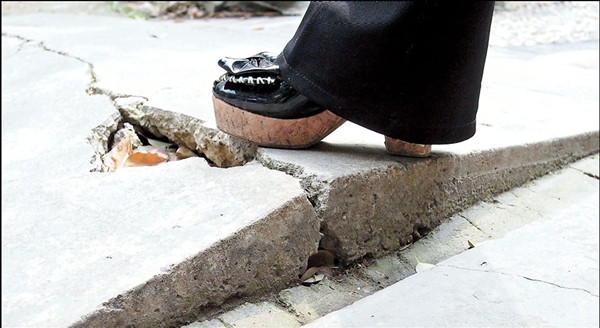

Huge cracks can be seen on the pavement of a residential building in Shiliuyuan Community on Luyang Road in Putuo District. The district government yesterday promised to repair the damage and fix the cracks, which the more than 400 residents of the building have blamed on the Metro Line 11. — Dong Jun
The Putuo District government has said it will fix the cracks and severe subsidence in one of the residential building which houses over 400 residents.
Residents of the Shiliuyuan Community on Luyang Road first noticed the subsidence and cracks on the walls in April last year. Over the months, the cracks got bigger and wider almost the size of a palm.
The district government invited experts from the Shanghai Housing Quality Inspection Station to work out a plan to stabilize the structure from the foundation. Construction work will begin soon, government officials said.
"I am afraid ... It is not safe to live here," said a woman resident surnamed Wang. "I hope the district government can solve the problem as soon as possible."
The six-story brick and concrete structure was built in 1996, but now, some of the windows and doors need some effort to open. Even the foundation seems to be inclining with residents saying they have noticed that balls roll down the same direction.
Wang said small stones and particles fall from the cracks and hit people.
The residents insist that the subsidence began in 2007 during the construction work of Metro Line 11 that runs under the complex. A Shanghai Television Station report said the shield machine used to dig the tunnel for the subway caused the subsidence.
The structure began shifting and the cracks on the wall started becoming more visible after Line 11 started operations, another female resident surnamed Han said. In 2010, the Taopu town government spent more than 10 million yuan to fix three of the damaged buildings in the community, but it soon started affecting other structures, she said.
Though the government said it was still investigating, residents have no doubt about the reasons, saying the building sways every time a train passes underneath. The community is about 1,000 meters away from the Taopu Village station.
"Whenever a train passes below, I can feel the strong vibration," said Liu, who lives on the fourth floor of the building. "I have lost sleep over it."
The condition of other buildings are a little better, but residents still complain that the noise and vibration makes it difficult to live. "I don't think filling up gaps can solve the problem. The only way is to pull down the dangerous houses and build new ones of better quality," Han said.
The subway builders said they are closely monitoring and controlling the ground subsidence and leaks by tagging tunnel materials and tracing the construction process. The tagging of tunnel duct pieces using Radio Frequency Identification Device technology is being used for the under-construction Line 12 in downtown Xuhui District, the Shanghai Urban Construction Group said.
Data on leaks, cracks and subsidence will be delivered to engineers for analysis and adjustment.
Shanghai's land has subsided by 29 centimeters in the past 40 years, becoming a major geological threat for a city with an average altitude of only 4 meters above sea level, city officials have said.
Subsidence takes place when groundwater is pumped out during the construction of foundations for high-rises and Metro lines, Feng Jingming, the former director of the Shanghai Planning and Land Resources Bureau, said.
Shanghai has become like a reversed bowl cover — low in the middle and higher in the surrounding areas, according to Tang Yiqun, a professor with the geological environment research center of Tongji University.
Bridge approach sees over 200 cracks in Haikou
2013-08-08Copyright ©1999-2018
Chinanews.com. All rights reserved.
Reproduction in whole or in part without permission is prohibited.